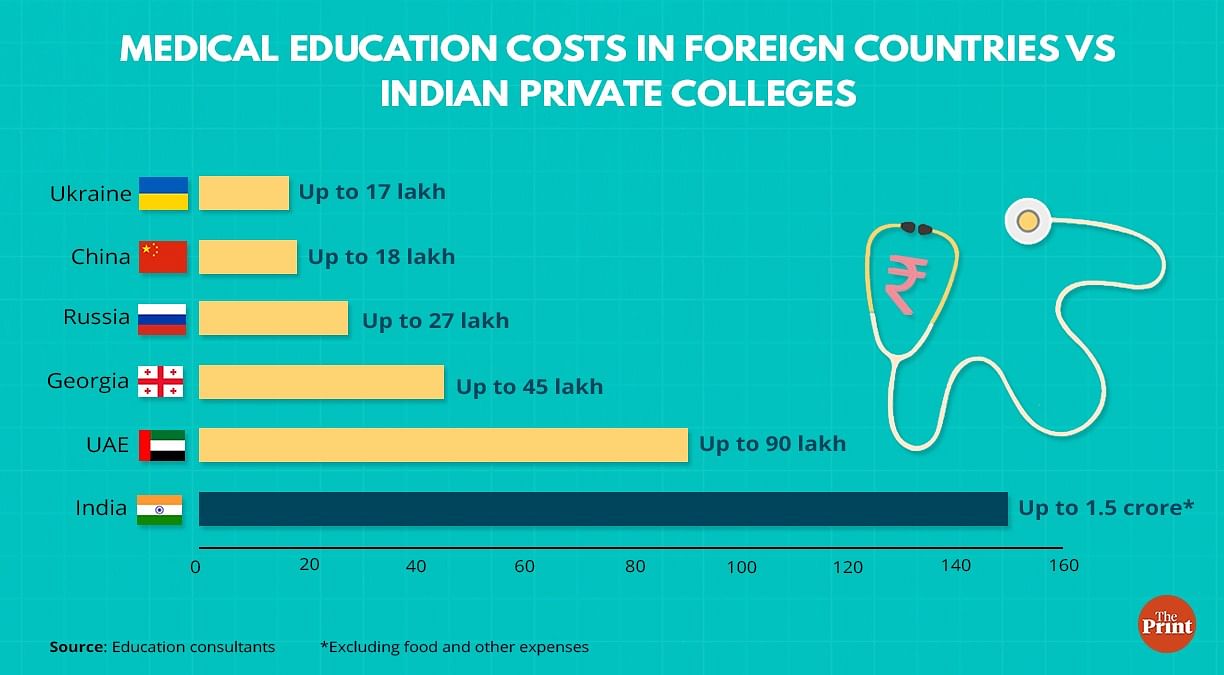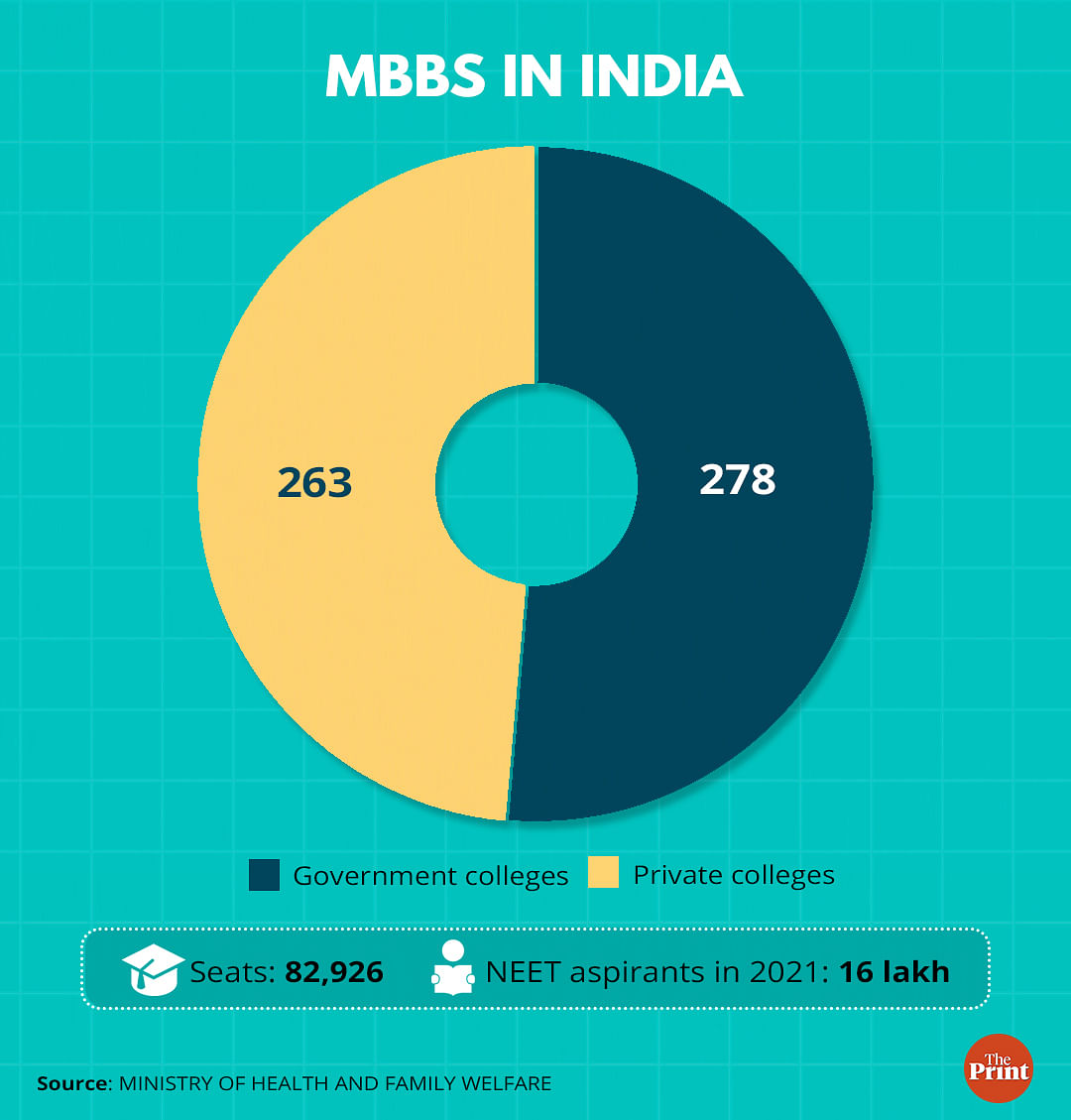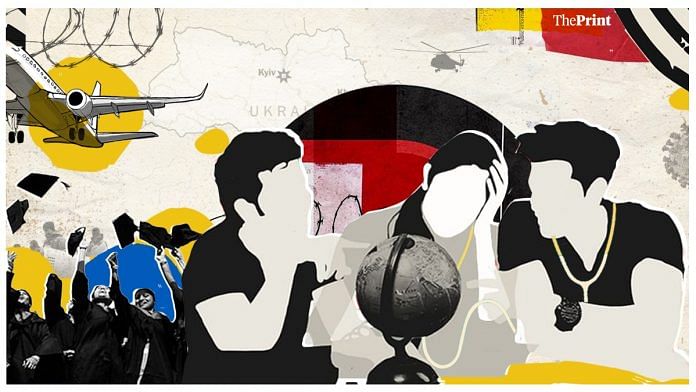New Delhi: Bhoomi Tripathi fears her dream of becoming an MBBS doctor might now remain just that. The 20-year-old from Varanasi has been trying to secure admission in foreign medical colleges since she finished schooling three years ago. But the Russia-Ukraine war has now shrunk her options drastically. And she is considering dropping the idea completely.
“China has stopped giving visas to Indian students after the pandemic. Security concerns have become a deterrent in Ukraine. And Russia has bilingual education,” Tripathi told ThePrint. “Affordable education options for Indian medical students are shrinking. Egypt is my only hope for now. If that does not happen, I will get an admission in some BSc course here in India.”
She said a lot of her friends are now opting for alternative science courses this year as foreign medical options seem fewer.
The National Medical Commission (NMC), the regulatory body in India for medical education and professionals, has advised students against applying to Chinese Universities, after the Chinese government stopped issuing visas to students in light of the Covid-19 pandemic.
Russian universities largely offer bilingual courses, making them unacceptable, according to the latest NMC guidelines, which mandate English as the sole medium of instruction. Additionally, the NMC, in its latest notification last month, advised students against applying in universities in Kyrgyzstan, another former USSR constituent, “after it came to know that many students were overlooking the supervisory, regulatory and infrastructural issues in these institutions”.
Now, the Russian invasion has ruled Ukraine out too.
Consultants claim that students will now have to shell out more money since the most affordable options are difficult to access.
A medical degree in Ukraine costs Rs 15 lakh-17 lakh for a six-year course — much cheaper than private medical colleges in India that charge anywhere between Rs 30 lakh and Rs 1.5 crore. In Russia, the cost varies between Rs 20 lakh and Rs 27 lakh, while it’s Rs 35 lakh-45 lakh in Georgia. The cost in China is up to Rs 3 lakh annually.

In contrast, countries like the the UAE and Germany offer medical education at relatively higher costs, ranging between Rs 60 lakh and 90 lakh, making them nearly as expensive as private colleges in India.
There is also the factor of ease of admission.
For admission in medical colleges in Ukraine, Indian students need a NEET score of 135-150 out of a total 720, and a qualifying percentage of 60 and above in Class 12. Countries like China, Russia and Georgia have similar cut-offs. But to get admission into top government colleges in India like the All India Institute of Medical Sciences (AIIMS), a student needs to get over 650 marks in NEET and score well in Class 12 exams at the same time.
Prince, a 32-year-old looking for medical education for his 21 year-old brother, has a story similar to Tripathi’s.
“We cannot afford private medical education in India, which is why we are considering foreign universities. The war in Ukraine has thrown our plans off the path. Other countries are considerably more expensive than Ukraine,” says the Uttar Pradesh resident.
Also read: ‘Gunmen asked why don’t you join our fight’: Indian students recall nightmare of exiting Ukraine
Why students go abroad
According to a government reply in Parliament in 2020, India offers a total of 82,926 MBBS seats, in 541 medical colleges, including 278 government and 263 private institutes. For perspective, in 2021, over 16 lakh students appeared for the NEET exam.

As a result, students seek private medical education abroad.
Government data provided to Parliament in 2021 showed that there are 2.19 lakh Indian students in the UAE, 2.16 lakh in Canada, 2.12 lakh in the US, 23,000 in China, 18,000 in Ukraine, 16,500 in Russia, 15,000 in the Philippines, 7,500 in Georgia, 5,300 in Kazakhstan, 5,200 in Bangladesh, and 2,200 in Nepal. These numbers aren’t exclusive to medicine and, hence, the list includes countries that aren’t attractive propositions for medical students.
But with China, Russia and Ukraine out of the mix, and Kazakhstan facing NMC restrictions, foreign options are going to get increasingly difficult, say education consultants in Delhi.
“As per latest NMC guidelines, countries like Kazakhstan, Russia etc are no longer a lucrative option for Indian students… The NMC requires the entire medical course to be in English,” said Tribhuwan Singh, a consultant with the Edunial Infotech Group.
“Most Russian colleges have a bilingual course and several Kazakh universities were blacklisted in 2021 by the NMC, shrinking students’ options further.”
Nations like Kyrgyzstan, Kazakhstan, Russia, Georgia and Belarus are preferred by students over India’s neighbouring countries like Nepal and Bangladesh because of the large intake in their universities.
“The reason why these countries were popular destinations was not only because they are pocket-friendly but also for the kind of seats that they have. Medical universities in Nepal have about 600 seats for foreign nationals, Bangladesh has about 1,100 such seats, China has about 2,900 seats, Egypt has about 500 seats,” Hope Consultants’ Dipendra Chaubey said.
“On the other hand, countries like Russia, Ukraine, Kyrgyzstan have 500-1,000 seats per university, leading to a mass movement of Indian students to these countries,” he added.
Chaubey claimed that the trend of Indian students going to Ukraine started only in 2014. Before that, China, Russia and Nepal were the most sought-after options since 1999.
Moreover, several education websites mention that universities in these countries provide good quality education as compared to private universities in India.
According to a report, the Medical Council of India, which preceded the NMC as regulator, had issued 3,386 more eligibility certificates to foreign medical aspirants in 2018 (17,504) than in 2017 (14,118), showing a rise in the number of students going abroad by about 24 per cent.
Despite the deteriorating situation in Ukraine, Tejendar Singh of DSA Global is optimistic, saying that if the war ceases in a couple of months, then students will most likely seek admissions in the country, which begins intake in September.
Also read: Russia-Ukraine war is setting ‘risky’ precedence for Indo-Pacific, EU envoy to India says
Rules for students and how they fare upon return
The NMC guidelines issued in November 2021 listed important rules for foreign medical students, one of which is that the entire course of education in the foreign country should be in English.
The other condition is that students must complete the MBBS course in 54 months (4.5 years), along with a 12-month internship in the same foreign university.
The other mandate includes that after clearing NEET in India and completing their foreign education, students must be eligible to practise in the country of their education, which means they should be a registered doctor there.
All students who acquire a medical qualification from certain countries are required to clear the Foreign Medical Graduates’ Exam (FMGE) in order to practise in India, according to the Indian Medical Council Act, 1956.
According to Ministry of External Affairs data, 6,170 students with medical degrees from institutions abroad appeared for the FMGE in 2009. By 2018, this number jumped over three times to 21,351.
However, the pass percentage of students appearing for the FMGE has been very low, and has remained below 20 per cent.
Uncertainty and loss for returning students
With global security potentially under threat for an uncertain period, the road ahead is rocky for those students who have already returned to India, leaving their education midway.
Panipat resident Sumit, 22, said online classes could become the new reality from 12 March, when his Ukrainian college was to reopen. He is hoping that Ukraine universities will issue some kind of guidelines to this effect.
“During Covid, we were struggling and classes were shifted online… Now again we have been promised that our course will happen online. This has taken away from our internship or practical experience. All our learning at this point is only theoretical, which is a major loss for us,” the fifth-year medical student said.
“Our future is mired in uncertainty now. We don’t know if we will be eligible to sit for the Indian medical exam without the practical experience,” said another student who didn’t wish to be named.
The 21-year-old added that Ukraine-returned students are hoping that the Indian government will take their circumstances into consideration and make arrangements for their further education.
(Edited by Amit Upadhyaya)
Also read: PM Modi appeals to stakeholders to speed digital varsity set up, says it’ll solve ‘problem of seats’



